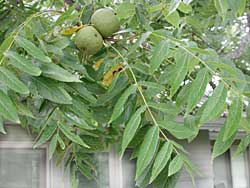| Compound Leaves | |
|
Compound leaves have more than one leaflet, usually several, attached to the same leaf stalk. The entire stalk with all its leaflets come out of the same bud in the spring. The entire stalk and its leaflets fall off in autumn. |
|
| Mockernut Hickory | |
|
 |
 |
|
| Black Walnut | |
|
 |
 |
|
| Honey Locust | |
|
 |
 |
|
|
 |
|
|